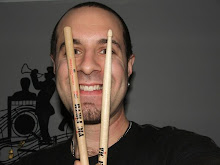Hey there everyone,
Before I get into it, my apologies for falling off of the face of the earth. Suffice to say my career has been in full-swing and keeping me away from the computer keyboard.
I recently began working with one of my longtime students on the art of Jazz drumming. He's had some experience in the style but it barely scratched the surface. We developed a curriculum for him that consists of 5 parts:
1. Listening.
2. Swing groove study.
3. Independence (as applied to Jazz).
4. Song forms (as applied to Jazz).
5. Soloing.
Each of these parts has its own particular areas of focus, and I'll get to them in future posts. Today I wanted to talk about one area that is particularly challenging to many drummers and that relates to the soloing portion of my Jazz education curriculum: playing melodically.
Drummers are taught things that relate to numbers. We study things like counting, patterns, phrasing, etc. After years of conditioning your mind and body to play rhythm, it can be really tough to change ones approach entirely and think about something so foreign as melody.
Pitch? Color? Shape? Rise and fall? Wtf is this??
When I work with students I tend to ease them into all of it. Since it's such a departure from what we usually study, it can take some time to develop the part of the brain that can process concepts that are more abstract.
The first step is to think of a song you know and enjoy. Try to sing the melody in your head. Then, play the rhythm of the melody on a snare drum (or other surface). Practice doing this for a few days...make it a part of your practice regimen. The goal here is to get used to playing a rhythm that comes from a melody in your mind...as opposed to a groove or a rudiment or a written part.
Once it becomes less awkward to do this, try orchestrating the rhythm around the kit. While doing this, pay attention to the pitch of your drums. Even though your drums might not produce an exact harmonic pitch, consider whether a drum is a 'high note' or a 'low note' or something in between. The goal here is to consider your drumset as a melodic instrument with a range of pitches. Oh and don't forget about the cymbals, they count too!
Try to think less and less about rhythmic concepts such as grooves, rudiments, fills, etc. and think more about performing pitches. Now, remember the melody we used before? Try to play the melody on your kit. When the pitch of the melody is high, play a surface that has a high pitch such as a hi-hat, splash, high tom, or snare. When the melody goes down in pitch, follow suit on the kit...play the lower toms, the larger cymbals, the kick. See what I'm getting at here? Even though your kit isn't a melodic instrument per se, the idea here is to start to CONSIDER it as one.
If you're thinking this is 'out there' or 'abstract', well that's 'cuz it is. This will take some getting used to. As I said before, we all have years of rhythmic programming that we need to learn to set aside. As we continue to practice playing melodically, we start to develop a new part of our mind.
Eventually, we can combine both approaches, rhythmic and melodic, to create interesting, musical, expressive solos. What's more is we can use this approach to create more interesting and appropriate grooves as well.
Thursday, September 15, 2011
Subscribe to:
Post Comments (Atom)

1 comment:
I am very much impressed with your article and I am happy that I am associated with your site.Excellent posting, and need your tips next time.
drums
Post a Comment